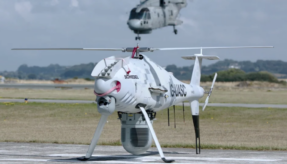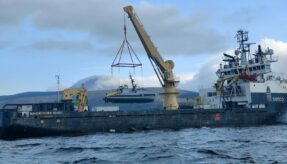
The strength of the UK defence aerospace sector is drawn from the supply chain that fuels it. With Farnborough International Airshow just around the corner, MOD DCB features writer Domhnall Macinnes talked to Paul Everitt, Chief Executive of ADS Group and Chairman of Farnborough International Ltd, about the event and the integral role of the UK defence aerospace supply chain in delivering capability.
Farnborough International Airshow 2016 – taking place on 11-17 July – will be alive with possibility as a host of major international aerospace and defence companies and hundreds of SMEs descend onto the arena floor to display their latest platforms and innovations. Farnborough’s enduring reputation as a premier international airshow is reflected in the number of both exhibitors and visitors in attendance from all corners of the globe.

Paul Everitt,
Chief Executive of
ADS Group and
Chairman of
Farnborough
International Ltd
Paul Everitt, Chief Executive of leading sector trade association ADS Group and Chairman of Farnborough International Ltd (FIL), said: “The world is coming to Farnborough. I think we’re expecting somewhere in excess of 1,500 exhibitors, with probably something in the number of 300 UK SMEs exhibiting at the event.
“It is very clearly a great opportunity to showcase UK expertise and new products and innovations and that’s predominantly because everybody will be there. It’s not just the major customers; it’s also the procurement teams from all of the major businesses. If you’re in the aerospace and defence business, this is the place where you’re going to present your products, and also meet the key people who are going to be purchasing them.”
The UK aerospace sector is the largest in Europe and second worldwide only to the USA. Turnover in 2015 was £29.2Bn with exports worth £26.3Bn. The need for innovation extends deep into the supply chain. Prime contractors are heavily reliant on the ability of this value chain to deliver the technology, innovation and competitiveness their customers require. As Mr Everitt notes, while innovation is required for new technologies and capabilities in the marketplace, such as censor or communication technologies, and indeed for aircraft themselves, there is much more to be considered.
He explained: “It’s also about innovation in the delivery of products and services. I’m always struck that when you talk to the UK MOD about their £178Bn equipment programme over the course of the next decade, half of that is actually about support. Certainly, when industry and government talk about innovation, they are also looking at the way in which products and services are made available and sustained over the lifetime of that contract.”
It is true to say that some of today’s most innovative capabilities originated deep in the supply chain. Tapping into the supply chain and driving collaboration is a goal of both prime contractors and government, and measures are constantly being put in place to encourage such synergy.

Mr Everitt noted: “If we consider the Strategic Defence and Security Review, the whole role of growth partnerships – and particularly the Defence Growth Partnership (DGP) – was highlighted. It is one of the key ways that industry is collaborating to identify potential innovations, technologies, products and services, and that particular role is being led by the UK Defence Solutions Centre (UKDSC), which is a key construct of the DGP. UKDSC has led a number of Innovation Challenges on behalf of the MOD, looking both to try and bring innovative new technologies into the sector and to identify them from within the sector.
“There is also an initiative run by the DGP called the Dual Use Technology Exploitation programme, or DUTE. It looks at bringing into the defence sector technologies and innovations that have been utilised in other sectors, such as motorsport, civil aerospace and wider mobile communications.”
He continued: “We are very much focused at ADS on encouraging what we would term pre procurement engagement. This is really encouraging both MOD purchasing teams and prime contractors to present to the marketplace the problems they are looking to resolve and then organising and orchestrating opportunities to reach out to the wider UK industry. This is to ensure that industry is getting the best understanding of what’s actually available in the marketplace. It’s also about being better aware of how to structure some of the contractual arrangements to maximise the innovations and innovative opportunities that sit within the supply chain.”
Advising on how a company can break into the lucrative defence aerospace market, Mr Everitt stressed the importance of joining ADS and grasping the opportunities it presents.
“ADS is the most appropriate way into the marketplace. We organise a whole range of events and opportunities for companies to understand more about the marketplace and be able to engage and network with customers, both within the prime contractors and within the defence community. This opportunity is open to members and nonmembers alike. We also do quite a lot in terms of organising and orchestrating a UK presence at Farnborough, as well as other major international aerospace and defence exhibitions.”
Mr Everitt touched some more on the excitement sure to be found at the forthcoming Farnborough 2016 event, and why the F-35 Lightning II Joint Strike Fighter – due to make its UK debut at the show – is a shining demonstration of UK defence aerospace capability.

© Lockheed Martin
Mr Everitt concluded: “Obviously one of the most exciting parts of this year’s show will be the F-35, which will be flying for the first time in the UK. It’s a great opportunity for people to see what it can do. Perhaps more importantly, however, it’s a chance for those who are contributing to the aircraft to see it in action.
“The UK is a major partner in the production of the F-35. Fifteen per cent of the value of every F-35 is produced here in the UK, so it will be a fantastic opportunity to demonstrate the UK’s important role in defence aerospace. There will of course be more traditional platforms on show, such as the Typhoon, so Farnborough International Airshow 2016 will also be incredibly important for the UK in presenting Typhoon to international customers.”
If you would like to read more articles like this then please click here
2015 Strategic Defence and Security Review (SDSR) ADS DGP F35 F35 Lightning Farnborough International Air Show FIA2016 Innovation Challenges MOD Paul Everitt procurement Procurement & contracts SMEs supply chain UK UK Government UKDSC








